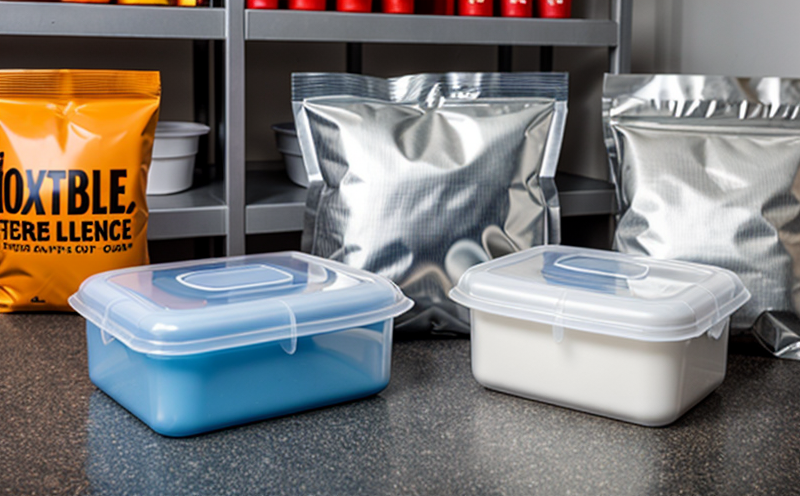ASTM D3895-12 Oxygen Barrier Verification
The ASTM D3895-12 standard test method is a critical procedure used to determine the oxygen transmission rate (OTR) of flexible packaging materials. This test is essential for ensuring that packaging meets specific performance requirements, particularly in applications where the integrity of the product must be preserved by preventing oxygen from penetrating the package.
Understanding the importance of OTR starts with recognizing how it impacts food safety and shelf life. Oxygen can react with fats, oils, and other components of packaged goods, leading to spoilage or degradation. By verifying that a packaging material has an adequate OTR, manufacturers can ensure their products remain fresh and safe for consumption.
The ASTM D3895-12 test measures the amount of oxygen that passes through a specified area of the packaging film per unit time at a specific temperature and humidity. This allows for precise control over conditions to simulate real-world storage environments accurately. The results provide valuable insights into the material's ability to protect products from oxidative degradation.
Preparation of specimens is crucial in ASTM D3895-12 testing. Specimens must be cut to standard dimensions and prepared according to the test method’s requirements. Ensuring that the specimens are representative of the final packaging design is paramount for accurate results.
The equipment used in this test includes a diffusion cell, which operates under controlled temperature and humidity conditions. The cell contains a membrane made from the material being tested, through which oxygen diffuses. On the opposite side of the membrane, there is an atmosphere with a known concentration of oxygen. By measuring the change in OTR over time, one can calculate the OTR value.
The test typically runs for 24 hours at standard conditions (38°C and 75% relative humidity). After this period, the concentration of oxygen on the opposite side of the membrane is measured. The difference between the initial and final concentrations provides the rate of oxygen transmission through the material.
The results from ASTM D3895-12 are used to determine whether a packaging material meets specific performance standards set by regulatory bodies or internal quality control protocols. These values help in selecting appropriate materials for different product types, ensuring that the chosen packaging effectively protects against oxygen ingress while maintaining the desired shelf life.
| Parameter | Description |
|---|---|
| Test Method | ASTM D3895-12 |
| Objective | To measure the oxygen transmission rate of flexible packaging materials. |
| Temperature | 38°C ± 1°C |
| Humidity | 75% ± 2% relative humidity |
| Testing Time | 24 hours |
Why It Matters
The ASTM D3895-12 Oxygen Barrier Verification test is crucial for ensuring the integrity and quality of flexible packaging materials. By accurately measuring the OTR, manufacturers can prevent product spoilage due to oxidation, extend shelf life, and maintain food safety standards.
For food packaging, oxygen barrier testing ensures that products remain fresh and safe longer. This not only enhances consumer satisfaction but also reduces waste by minimizing the need for frequent replacements or restocking of expired goods. Additionally, meeting regulatory requirements through proper testing can help avoid costly penalties and potential recalls.
In medical device packaging, maintaining an oxygen-free environment is essential to prevent product degradation and ensure sterility. ASTM D3895-12 provides a reliable method for verifying that the chosen materials meet these stringent standards.
For electronics manufacturers, protecting components from oxidation during storage or transport is critical. Flexible packaging with appropriate oxygen barriers can safeguard sensitive electronic parts, ensuring they remain in optimal condition until use.
Industry Applications
- Flexible food packaging to extend shelf life and maintain product quality.
- Medical device packaging to ensure sterility and prevent degradation.
- Electronics packaging to protect sensitive components from oxidation.
- Beverage containers to preserve flavor and aroma.
Environmental and Sustainability Contributions
By ensuring that flexible packaging materials meet the necessary oxygen barrier requirements, manufacturers can significantly reduce waste. Products with effective oxygen barriers are less likely to spoil or degrade prematurely, leading to reduced food waste and a lower environmental impact.
The ASTM D3895-12 test also supports efforts towards more sustainable manufacturing practices by helping companies select the most appropriate materials for their specific applications. This ensures that resources are used efficiently without compromising product quality or safety.
Furthermore, meeting regulatory standards through rigorous testing like ASTM D3895-12 can help businesses comply with environmental regulations and contribute to overall sustainability goals within the industry.





